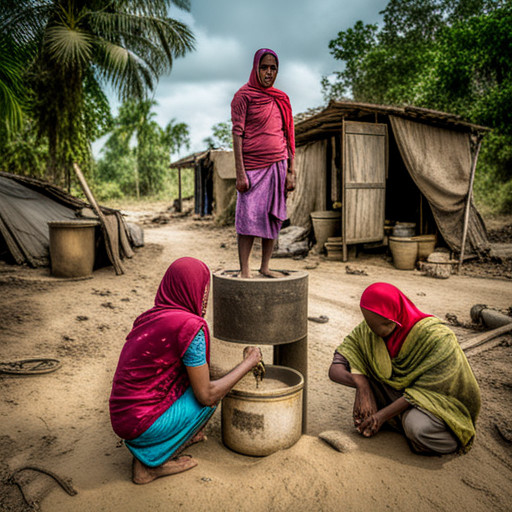Toxic Water Effects: A Closer Look at Case Studies
This article investigates the detrimental effects of toxic water through detailed examination of two case studies: Flint, Michigan and Bangladesh.

By highlighting the profound health and socio-economic implications of contaminated water supplies, it underscores the vital importance of stringent clean water regulations.
Furthermore, this analysis explores effective strategies for mitigating and preventing future instances of toxic water contamination.
Key Takeaways
- Industrial waste, agricultural activities, sewage discharge, and improper disposal of household waste are major sources of toxic water contamination.
- Case Study 1: The Flint, Michigan Water Crisis resulted in lead contamination, increased blood lead levels in children, and a Legionnaires' disease outbreak.
- Case Study 2: Bangladesh faces arsenic contamination in groundwater, leading to chronic arsenic poisoning and limited access to safe water resources.
- Toxic water contamination can have severe health consequences, including chronic diseases, neurological disorders, hormonal imbalances, and developmental abnormalities. Effective clean water regulations, technology advancements, policy enforcement, public awareness campaigns, and private sector engagement are key strategies for mitigating contamination.
Understanding the Impact of Toxic Water

The impact of toxic water on both human health and the environment necessitates comprehensive analysis through various case studies. Numerous pollution sources contribute to the increasing toxicity levels in global water bodies, thereby raising serious environmental and health concerns. Industrial waste, agricultural runoff, sewage discharge, and improper disposal of household waste emerge as primary culprits in this regard.
Industrial waste is a significant source of heavy metals such as lead, mercury, cadmium which contaminate water bodies. These pollutants persist in the environment due to their non-biodegradable nature and bio-accumulate through food chains, posing severe health implications. Exposure to these heavy metals has been associated with chronic diseases like cancer and neurological disorders in numerous epidemiological studies.
Agricultural activities contribute to water toxicity by introducing harmful substances like pesticides and fertilizers into water systems. These chemicals can disrupt aquatic ecosystems and infiltrate drinking supplies causing adverse effects on human health including hormonal imbalances, reproductive issues among others.
Sewage discharge contains pathogens that can cause infectious diseases when they contaminate drinking or recreational waters. Inadequate treatment or improper disposal of sewage significantly heightens the risk of outbreaks such as cholera or typhoid fever.
Household pollutants composed mainly of cleaning products, pharmaceuticals also find their way into water bodies affecting both aquatic life and humans downstream. Long-term exposure can result in multigenerational impacts including developmental abnormalities.
Case Study 1: Flint, Michigan Water Crisis

In Flint, Michigan, a public health emergency emerged due to high levels of lead contamination in the local drinking supply. This crisis was a result of cost-cutting measures which involved switching the city's water source from Detroit's system to the Flint River in 2014. The corrosive nature of this new source caused lead from aging pipes to leach into the water supply.
Flint's aftermath reveals an alarming impact on both physical health and socio-economic conditions. Studies indicate a significant increase in blood lead levels among children residing in areas with high water lead concentrations. Additionally, there was an outbreak of Legionnaires' disease coinciding with the switch to Flint River as a water source, resulting in at least 12 deaths and numerous illnesses.
The community response manifested through extensive protests, advocacy for policy changes, and legal actions aiming for accountability and reparation. Grassroots organizations mobilized resources for supplying bottled water and filters while also conducting independent testing to reveal the extent of contamination. Concurrently, they worked towards raising public awareness about these issues nationally.
Also noteworthy is how governmental agencies responded; delayed action underscored systemic failures at multiple levels—local state and federal —resulting in widespread distrust among residents towards authorities. Consequently, a comprehensive recovery effort has been initiated which includes infrastructure upgrades along with medical support services focusing on affected children.
This case study illustrates how environmental injustice can disproportionately affect marginalized communities underscoring the importance of robust systems for monitoring and addressing such crises promptly.
Case Study 2: Bangladesh Arsenic Contamination

Shifting focus to Bangladesh, widespread arsenic contamination presents another compelling example of environmental injustice. The issue first surfaced in the 1990s when high levels of naturally occurring arsenic were discovered in the groundwater, a common source for drinking and irrigation. Despite decades of intervention and Arsenic Mitigation efforts by various local and international bodies, an estimated 35-77 million people remain exposed to unsafe levels today.
The Health Consequences of this exposure are severe and far-reaching. Chronic arsenic poisoning, or arsenicosis, manifests as skin lesions and can lead to cancers of the skin, lung, bladder and kidney. Furthermore, studies have linked prolonged exposure to developmental effects in children, cardiovascular disease and diabetes.
Efforts geared towards Arsenic Mitigation have primarily revolved around providing safer water options such as deep tube wells or rainwater harvesters. Yet progress remains stifled due to socioeconomic barriers including poverty and lack of education about the dangers associated with contaminated water consumption.
Consequently, millions continue to suffer from ill health effects while also confronting socioeconomic obstacles that impede access to clean water resources. This case underscores how environmental issues often intersect with social determinants of health - highlighting not only an environmental crisis but fundamentally an issue rooted in structural inequalities which perpetuate a cycle of poverty and poor health outcomes.
Lessons Learned: The Importance of Clean Water Regulations

Lessons gleaned from the arsenic contamination crisis in Bangladesh underscore the critical need for stringent regulatory measures ensuring access to clean and safe hydration sources. The incident, which exposed more than 57 million people to detrimental health impacts, underpins the significance of effective policy implementation and robust regulatory enforcement in safeguarding public health.
Research indicates that inadequate regulation led to widespread exploitation of groundwater resources without proper assessment of potential contaminants such as arsenic. This lack of oversight resulted in one of the world's largest mass poisoning events. It is evident from this case study that stringent regulations are prerequisite for preventing similar crises.
Policy implementation plays a paramount role here. Ineffective policies often result from insufficient knowledge about local conditions or disregard for potential long-term effects on water quality. Therefore, comprehensive understanding of local hydrogeological conditions and possible contaminant sources should inform policy development.
Regulatory enforcement also forms a crucial part of this equation. Without rigorous enforcement mechanisms, even well-designed policies may fail to achieve their intended outcomes. Enforcement should therefore include regular monitoring and evaluation procedures, coupled with penalties for non-compliance.
Drawing from these lessons, it becomes clear that addressing contamination issues requires an integrated approach involving both robust regulations and their diligent enforcement. Furthermore, creating awareness among communities about water safety standards is integral to any strategy aimed at securing access to clean water.
Strategies for Mitigating and Preventing Toxic Water Issues

Addressing the issue of harmful contamination in our hydration sources necessitates a combination of proactive prevention methods and effective mitigation strategies. Research indicates that understanding pollution sources is crucial to developing appropriate contamination solutions.
Pollution Sources can stem from various sectors, including agricultural runoff, industry waste disposal, urban stormwater runoff, and improper sanitation systems. These contaminants often carry heavy metals, pathogens, chemicals, and other pollutants which pose significant threats to both human health and ecosystems.
Contamination solutions require a multifaceted approach involving technology advancement, policy enforcement, public awareness campaigns, and private sector engagement. Advanced technologies such as nanotechnology-based water treatment systems show promise for effectively removing pollutants at their source. Moreover, stringent regulation enforcement ensures consistent compliance with water quality standards across all relevant sectors.
Public education initiatives foster an informed citizenry capable of making sustainable choices that reduce individual contributions to pollution. Furthermore, engaging the private sector promotes the development of innovative solutions while also encouraging corporate responsibility in pollution management.
However complex these strategies may be; they provide a comprehensive approach towards addressing toxic water issues. Through proactive prevention methods that understand and address pollution sources directly combined with reactive mitigation strategies that involve technological advancements and community involvement - these solutions offer hope for improving water quality worldwide.
Frequently Asked Questions
What Are Some Examples of Toxic Water Crises in Other Countries Not Mentioned in the Article?
Examples of toxic water crises in countries beyond the article's scope include the Fukushima Daiichi nuclear disaster in Japan and arsenic contamination in Bangladesh. Both cases signify global implications, warranting robust prevention measures.
How Does Toxic Water Contamination Affect the Marine Life?
Toxic water contamination detrimentally impacts marine life, disrupting ecosystems and threatening biodiversity. Pollution legislation is crucial for mitigation, while sustainable solutions may offer preventative strategies to combat ongoing aquatic environmental degradation.
What Are the Long-Term Health Effects of Consuming Toxic Water?
Long-term consumption of toxic water can increase disease incidence, potentially causing liver damage, kidney failure, and neurological disorders. To safeguard public health, remedial measures such as filtration and chemical treatment are urgently required.
Are There Specific Age Groups More Vulnerable to Toxic Water Effects?
Environmental policies and community awareness play critical roles in mitigating exposure to toxic water. Vulnerability varies across age groups, with infants, children, and the elderly often demonstrating heightened susceptibility due to physiological factors.
How Can Individual Households Test Their Water for Toxicity?
Individual households can test water toxicity employing various methods such as filtering solutions and detection kits. Filtering solutions aim to remove toxins, while detection kits assess the presence of harmful contaminants in the water supply.
Conclusion
In conclusion, the analysis of case studies from Flint, Michigan and Bangladesh underscores the profound impact of toxic water on human health and socio-economic conditions.
These instances underscore the imperative for stringent water regulations to mitigate such crises.
Furthermore, they highlight the necessity for proactive strategies aimed at preventing contamination issues, thus reaffirming that access to clean, safe water is not merely a utility but a fundamental human right.

This post has been generated by AI and was not reviewed by editors. This is Not legal advice. Please consult with an attorney.




